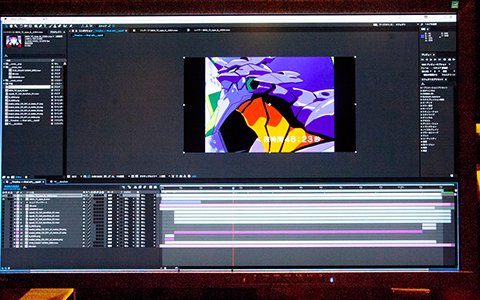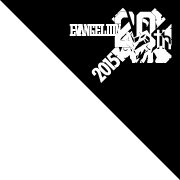The Problem That Stumped the Creative Team:
Ritsuko’s Eyebrows
The color correction process may have taken a year alone, but it wasn’t the only difficulty. Before all of that what they were waiting on was, of course, the main edit.
Fujimori:“The original main feature of the Evangelion TV series was on 16mm film. When turning it into HD it becomes grainy. The process to make that not stand out too much has to be done as a whole. After that there’s the restoration to clean up noise and dirt from the film and correcting painting errors from the production process, which each require specialist staff. The 2003 restoration fixed a lot of these problems, so based on the work list back then we added our corrections. Even so, things popped up that we hadn’t anticipated in making an HD version. The places which needed to be corrected sometimes increased in scope compared with the DVD production.”
Yukita:“One of the easiest ways to talk about it is through the problem with Ritsuko Akagi’s eyebrows. When you see her as a high school student you realise her original hair color was brown. However, as a grown up she’s blonde but her eyebrows are still brown. When you really look hard, there are quite a few scenes where her eyebrows are blonde too. A lot of these were fixed during the 2003 restoration, but we repaired the parts that you couldn’t see with the lower picture quality from back then and there were places that the checks simply hadn’t been thorough enough. This time we decided “Paint all the eyebrows!" (laughs). For that reason alone I watched the scenes Ritsuko appears in so many times. With Fujimori working right next to me, I was always just gazing at Ritsuko (laughs).”
Fujimori:“Having said that, I think that for a work that was done with cel animation 20 years ago Evangelion actually has relatively few mistakes. There are scenes which feature newspapers but the characters are blurred out in the SD picture quality. However, now when we tried to make the HD version you could read all of the characters. I found this very surprising. This is all because of the vast amount of information stored within the original film.”
Yukita:“This time in the scenes that feature newspapers or documents, if you really look closely you can read everything. Really, go and have a look yourselves. Anyway, we operated under the policy of correcting all the parts we noticed.”
Fujimori:“If it enabled us to create a superior product, we were willing to fix every cut. Under the directions from Hideaki Anno, there were a lot of places where we just fixed a few millimetres that you couldn’t even see at first glance. Also, as the editing equipment we used varied according to the kinds of corrections, we needed to use the manpower of the staff members from a different room outside the editing suite.”
Yukita:“When we talk about editing, we couldn’t do everything just in the studio. Fujimori was in charge of the editing process to the bitter end, but in some cases coordinating the essential skills for the product from the techniques our staff possessed and the equipment we had at the company also came to require something like communication ability to precisely convey the clients’ demands. For this project, I think that the work that Fujimoto was doing, compared with the usual package work was over and above the territory of ‘editing.’”
From 2010, each part of the project progressed independently, and the final edit ended in April 2015. Once you’ve started it’s not the sort of thing you can stop half way through. Up to now, all kinds of people have talked to route2015, but even if you make one video it seems to follow as the destiny of those connected with Evangelion.
Yukita:“In truth this is the first time Fujimori has worked on Evangelion - I was involved from the 2003 DVD. So naturally, I imagined this time would be strenuous work too. Even so, on the previous DVDs we worked really hard for about six months. Including the people at King Records, no one thought this would end up taking over five years (laughs).”

Of course, it wasn’t only simple corrections which were added during the editing process. In chapter 9 “Both of You, Dance Like You Want to Win!” the remaining time was indicated in the lower left corner of the screen. These characters were not present on the original film negative.
“Those characters exist because the director’s intention was to bring out a ‘video camera’ feeling. When creating a video master we correct each instance of these. This time too, in keeping with this intention we aimed at maintaining the original nature of the video as much as we could, so we made sure to re-enter each of these characters (Fujimori).”

